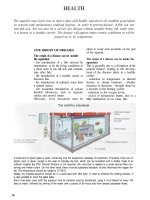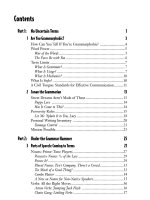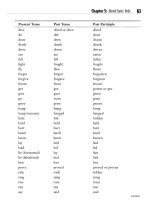The complete idiot guide part 2 pdf
Bạn đang xem bản rút gọn của tài liệu. Xem và tải ngay bản đầy đủ của tài liệu tại đây (490.33 KB, 10 trang )
Contents xvii
Letters of Opinion 350
Complain, Complain,
Complain
350
My
2c
Worth
352
E-Mail:
Instant Gratification 353
Boot
Up
354
Think
Before
You
Flame
355
Appendixes
A
Glossary
3S7
B
Model
Documents
361
C
Guide to Grammar and Usage
367
Index
395
According to most studies, people's number one fear is public speaking.
Number
two is death. Death is number two. Does
that
seem right?
That
means to the
average
person, if you have to go to a funeral, you're
better
off in the casket
than doing the eulogy.
—-Jerry
Seinfeld,
SeinLanguage
Picture this: You're standing in front of
a
large
conference room full of
business
associ-
ates.
You've put on your best new clothes for a special
occasion:
You're about to present
the project you've been working on for six hard months. You know it's a good
idea—
you've considered it from every
angle
and you're sure it can't
fail—but
you're not sure
you can
sell
everybody on it. In fact, you're scared to death of embarrassing yourself.
Why?
If
you're like most people,
part
of your fear comes from the worry
that
you might not
use good
grammar—wait,
make
that
proper
grammar—when
you start speaking, or
that
somehow you've messed up the writing in the 60-page
report
you've just handed
out. You don't have a run in your panty
hose—you
checked—but
your infinitives might
be split wide open. You can tell
that
your zipper's not down, but you've got this irra-
tional fear
that
your participles are
dangling.
You're a smart dresser, for
certain—but
are
you just plain smart?
In a word,
yes.
You are.
The most common myth about grammar is
that
people who don't use it correctly are
somehow
less
intelligent than those who do. Wrong! Intelligence and grammar are
unrelated. Consider Jerry Seinfeld, who is quoted at the start of this foreword. He's
an
incredibly clever comedian whose jokes are always built around insightful observa-
tions of the human condition. Now consider the quote itself. Frankly, if his grammar
were a car, they'd be towing it away to the junkyard right about now. It's a lemon for
sure—but
that
doesn't mean Jerry Seinfeld can't parallel park,
if
you know
what
I mean.
His sentences have a style that's appropriate for his
audience—and
he's been so suc-
cessful
at it
that
people have been copying him for
years.
Have you ever heard the joke about the boy named Cass who was absent for a few
days
in
first
grade, missed the lesson about the
letter
C,
then
for the
next
few
days
kept
getting into trouble for
signing
a cuss word
next
to the date on his homework papers?
This is how many people feel about
grammar—that
they were absent when their
teachers taught the basic rules and have been paying for it ever since. The
truth
is,
you were probably
there
when your teacher taught grammar. So why didn't you learn
the proper rules? Well, honestly, it could
be—at
least
partially—your
teacher's fault.
If
you were like almost every other unfortunate elementary school student, your teacher
probably sat in front of the room carefully
explaining—in
a voice dull enough to make
rocks start to fidget—how to parse sentences, how to conjugate irregular verbs,
what
past perfect tense means,
what
a gerund is, etc. Maybe you
also
got to read from a
textbook—oh
boy!—full
of
snappy,
interesting sentences about Tom and Sue and
Bob's
plain brown dog. It was a recipe for failure. Somehow you passed the
class,
of course,
but did you really take anything in? Did you master the
English
language?
Of course
not; nobody
could—not
in an environment like
that.
Your teachers were crazy to
expect
those lesson plans to work.
You did your best, under the
circumstances—and
now it feels impossible to go back
and set things straight.
But
it's not impossible, because the circumstances have just changed. Laurie Rozakis is
your teacher now. Trust me, you're in good hands. I've been teaching
with
Dr. Rozakis
for
several years now, and
what
always amazes me is how she makes grammar fun.
Her students laugh while they
learn—and
they definitely learn. She has a knack for
making even the most complex concepts simple, understandable, and memorable.
Her students love her.
They
also
respect
her—she's
not only an entertaining teacher, but a wise one. As far as I
can
tell, Laurie Rozakis knows everything
there
is to know about grammar and style.
This book is the
next
best thing to being in her classroom yourself. You'll remember
what
she teaches you and start using it in your daily life almost immediately. You'll
look
forward to reading this book just as much as you used to look forward to avoid-
ing
your homework. You'll be amazed at how
easy
it
is.
The conference room will
never be quite as intimidating
again,
either—and,
if you're lucky, you could pick up a
joke for the lunchroom, too.
Read
on and enjoy.
Gwydion Suilebhan
Gwydion Suilebhan is writing program coordinator and Curriculum
Content
Specialist
for the Institute for the Academic Advancement of Youth at
Johns
Hopkins
University. He
also
works as a freelance writer, teacher, and curriculum designer. A
collection of his poems, Inner
Harbor,
was published in 1997 by Woods House
Press.
Introduction
You know you have the intelligence, ambition, and resilience to succeed, but one
problem holds you back. "I'm afraid of making embarrassing errors when I speak and
write," you say to yourself.
When
it comes to expressing ideas or communicating your
opinion, you're afraid your message is garbled or just plain incorrect.
Having
washboard abs and a body-fat count lower than the inflation rate will get you
only
so far in
life.
You know you need to know the basics of good
writing—grammar,
usage,
punctuation, capitalization, and
spelling—to
get where you want to go. That's
why you bought this book.
Memorizing lists of grammar rules isn't the answer. Wading through dictionaries and
grammar books is about as exciting as watching reruns of
Gilligans
Island
or
Green
Acres.
Besides,
you can never find
what
you need;
there
are so many words! Your online
spell
checker drives you mad; the grammar checker buzzes like a pinball machine.
You know you need to do the following:
•
Understand how to use the different writing
aids,
including dictionaries,
thesauruses, style guides, reference books, and computer programs.
•
Identify the parts of speech and know when to use each kind.
•
Make
English
grammar work for you.
•
Write
logical,
complete, and graceful sentences.
•
Use correct capitalization and punctuation.
•
Write
effective letters, memos, and electronic
messages.
What
You'll
Learn
in
This
Book
Success-conscious
people are grammar-conscious people for many good reasons. You
know
that
if you want to get ahead in almost any business or profession, you must
speak
and write reasonably correct
English.
That's
what
this book can help you achieve.
You'll learn
that
business and personal writing is not a mysterious activity at which
only
a few people can succeed. Rather, writing is a craft, like barefoot aluminum foil
dancing
or cooking
that
can be learned by almost anyone willing to invest the required
time and energy.
xxii
The
Complete
Idiot's Guide
to
Grammar and Style,
Second
Edition
This book is divided into six sections
that
teach you the practical, hands-on grammar
and
usage
rules you need. You'll understand why certain rules exist and
what
function
they serve in writing and speech. Most of
all,
you'll finish this book convinced
that
writing is fun as well as useful and important.
Part
1, "No
Uncertain
Terms,"
first explores how many people feel about grammar,
usage,
and the mechanics of writing. This
part
provides the standards for effective
communication, too.
Next,
you'll get the definitions
of
grammar,
usage,
mechanics,
and
style,
so we're all starting this dance on the same foot. Then you'll
assess
your own
writing strengths and shortcomings to find out how you can improve your
writing—
right now!
Part
2, "Under the
Grammar
Hammer,"
gets into the nitty-gritty of grammar:
parts of speech, pronoun reference, pronoun
case,
verb
usage,
the difference between
adjectives
and adverbs, and subject-verb agreement. It's all the stuff you ignored in
high
school and
English
Comp
101
because you were too busy trying to get a date.
This
part
concludes
with
a survey of the most common
usage
dilemmas. Along the
way,
there
are lots of brand-new ways to make it easier for non-native
English
speak-
ers
to learn the basics of
English.
Part
3, "Usage and
Abusage,"
describes the building blocks of
paragraphs:
phrases,
clauses,
and sentences. You learn all about prepositional phrases, appositives and
appositive phrases, verbal phrases, gerund phrases, and infinitive phrases. This
part
also
covers sentence structure and function, fragments and run-ons, and sentence
coordination and subordination. This sounds heavier than a sumo wrestler, but you
know I'll make it fun.
Part
4, "Tools of the
Trade,"
first explores the importance of
using
all the resources
available
to writers: dictionaries,
computer
spell-checkers, books of
synonyms
and
antonyms, and reference books. Then I
give
you a complete refresher course in the
signposts
of our
language:
punctuation, capitalization, abbreviations, and spelling.
Part
5,
"Style:
All the
Write
Stuff," helps you
give
your writing
grace,
clarity, and
that
essential^
ne
sais
quoi
that
separates your writing from everyone
else's.
This
sec-
tion
also
covers active and passive voice, conciseness, diction (word choice), and levels
of
language.
Part
6,
"In
Your
Write
Mind,"
helps you develop powerful writing strategies
that
enable you to
write
successful business and personal communications. This
part
cov-
ers
such important writing situations as business and personal letters and e-mail. In
the chapter on personal communication, you'll learn how to
write
effective letters to
friends,
companies, and people suffering
losses.
Introduction xxiii
Last,
there's an appendix of model writing samples and a
glossary
of grammar and
usage.
The
glossary
of grammar and
usage
makes it
easy
for you to pinpoint specific
writing
issues
and get the answers you
need—-fast!
I
More
for
Your
Money!
In
addition to all the explanation and teaching, this book contains other types of
information to make it even easier for you to master writing and speaking
skills.
Here's how you can recognize these features:
Strictly
Speaking
Want to dazzle your date?
Stump
your
spouse?
Have
some
witty
chitchat for the next office
party?
Use these grammar
teasers
to astound and amaze
your friends and enemies alike.
You
Could
Look
It Up
Like
every other skill
worth
knowing, grammar and
usage
have
their
own terminol-
ogy.
These
definitions explain all
those
terms to prevent you
from
dangling your participles in public.
Take
My
Word
for
It
You
could skip these tasty
tid-
bits,
but you
won't
want to
because
they're too much fun!
Danger,
Will
Robinson
These
warnings help
you
stay
on
track—so
you
don't
end up lost in
space.
Quoth
the
Maven
,
t
Vr
These
are
little
expert tips
that
make
correct
writing
easier.
Acknowledgments
To my long-suffering husband, who endured bologna rather than turkey
with
his
cranberries,
stuffing, and
gravy.
(Okay, so I
was
a little preoccupied
with
this book to
make the turkey.
Bologna
is
a recognized food group.) He has
always
been my
strongest
supporter and staunchest friend.
xxiv
The Complete
Idiot's
Guide to Grammar and Style,
Second
Edition
And to my dear children Charles and Samantha, please stop referring to The Night
Mom Forgot the Turkey. It is not a national holiday. I promise to remember the
large
dead
bird at any and all appropriate
future
meals.
Also,
a tip of the hat to Gary Goldstein, my editor for the second edition of this
book. Tom Stevens, development editor, and Keith
Cline,
super copy editor, deserve
credit for making me look much smarter and more careful than I am! And much grat-
itude to the amazing Christy Wagner, senior production editor, a fabulous colleague
and
production editor par excellence.
My
deepest thanks to Marguerite Owens
Kassinger,
Amy
Losi,
Joanne Marrone, and
Charles
Rozakis for providing
resumes.
And a
kiss
for
Pessha
Snedeker, president of
the southwest division of my fan club!
Special
Thanks
to the
Technical
Reviewer
The
Complete
Idiofs
Guide
to Grammar and
Style,
Second
Edition,
was reviewed by an
expert
who double-checked the accuracy of
what
you'll learn here, to help us ensure
that
this book
gives
you everything you need to know about grammar and style.
Special
thanks are extended to Doug Stein.
Doug Stein recently retired from the New York City School System, where he taught
high
school
English
and History for more than
3
5
years (and has lived to tell about
it).
He now does private tutoring in the New York City area in these
subjects—when
not rescuing
dangling
modifiers for Alpha
Books
and others fortunate publishers and
writers. He now keeps busy freelance writing and editing for a number of
local
publi-
cations.
When
not working, he resides
with
his wife, Gail (the author of The
Complete
Idiot's
Guide
to
Learning
Spanish
on
Your
Own) in New York City.
Trademarks
All
terms mentioned in this book
that
are known to be or are suspected of being
trademarks or service marks have been appropriately capitalized. Alpha
Books
and
Penguin
Group
(USA) Inc. cannot attest to the accuracy of this information. Use of
a
term
in this book should not be regarded as affecting the validity of any trademark or
service
mark.
No
Uncertain
Terms
In 1983, a linguist named Geoffrey Nunberg published an
essay
called
"The Decline of Grammar" in the Atlantic Monthly magazine. The article
described the
battle
between
different approaches to grammar and language
usage.
Truth
be told, the article was
about
as dry as
unbuttered
melba toast.
Nonetheless, the magazine was deluged
with
letters, many of
them
quite
irate.
When
the smoke cleared, the editors realized
that
they had received
one of the largest reader responses in
years.
More than two decades later, most of the burning issues of the early 1980s
have cooled, but interest in language usage remains as fierce as ever. And
you
thought
your
mother
was the only one who cared if you said, "Can I
go
to the bathroom?" instead of "May I go to the bathroom?"
Now
that
you've finally gotten permission to go
potty,
it's
time
to see
what
grammar,
usage,
mechanics, and style are all
about.









